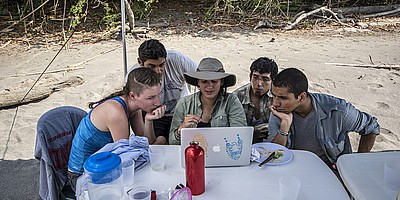The Evolution of the Andean-Amazonic Region

Gustavo Béjar, third year student at Yachay Tech University, was selected to join a research project whose objective is to collect fossils in Peru to allow to understand the change in biodiversity in the Andean-amazon region after the formation of the Andes. The project is funded by National Geographic and the National Science Foundation.
In the XVIII century, James Hutton, one of the fathers of Geology, had thought that the importance of studying the earth lies on knowing and understanding the processes that helped it become what it is today, and to understand how these processes will make it to the future. Although it was known that the small department of Madre de Dios in Peru has a significant presence of fossils, no research had been conducted in the area yet. Rio Alto Madre de Dios, basin of the Amazon river, is located in the center of this department where a research team sponsored by National Geographic Society and the National Science Foundation of the US is performing several field activities to create a record of the fossils in the area and later conduct an analysis that will allow them to understand the change in the Andean-amazon region after the formation of the Andes.
Paul Baker, Ph.D., Dean of the School of Geological Sciences and Engineering of Yachay Tech, leads the project together at Universidad de Piura with doctoral students from Duke University (United States.) This team went on an excursion on July and August where they collected fossils to be dated. The fossils were mainly from rodents.
The finding process, prior dating, consists of examining the sediments in the research area. If the sediment is deemed as a potential host of fossil material, they are extracted with a shovel and transported to the camping area where the samples are purified until finding fossils. The team found a great number of fossils at the research area, including bones, teeth, and paleosols. The next step was to create molds similar to the ones dentists have, to be able to perform an in-depth analysis of the fossils, because the original samples cannot be taken out of Peru. The next step in the process is dating the fossils.
Additional age dating of the rocks is undertaken by collecting large volume samples of sandstone. These sandstones contain small quantities of the heavy mineral, zircon. Within these tiny zircon grains, radioactive uranium decays through time to stable lead. Thus, the uranium/lead ratio of these grains yields a quantitative determination of the age of the sandstone.
Lastly, the main benefits that these type of research can bring to society are: maintaining biodiversity and conservation of the ecosystems; knowing where they come from and where the species of living organisms of the Andean-amazon region go, and why they are where they are and why they are the way they are.
The results of the research performed by Paul Baker, Gustavo and the rest of the team in Madre de Dios will be of great relevance for the region as no other detailed analysis of the paleontology in the area has been done before, and it is crucial to understand how our continent has evolved.